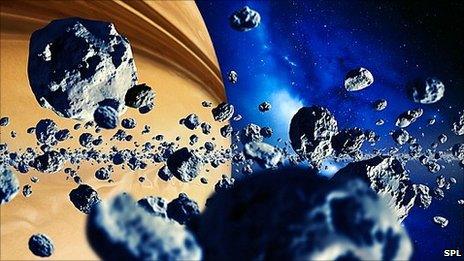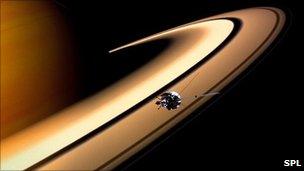Giant moon collision 'may have formed Saturn's rings'
- Published

Saturn's rings are largely made up of icy chunks
Saturn's rings may have formed when a large moon with an icy mantle and rocky core spiralled into the nascent planet.
A US scientist has suggested that the tidal forces ripped off some of the moon's mantle before the actual impact.
The theory could shed light on the rings' mainly water-ice composition that has puzzled researchers for decades.
The scientist announced her idea at a conference in Pasadena, US.
Though the rings are now thought to consist of 90-95% water-ice, Robin Canup of the Southwest Research Institute in Boulder said the slight rock content is due to the interplanetary dust and constant "bombardment … by micrometeoroids".
"[The rings] must have formed as essentially pure ice," she said at a meeting of the American Astronomical Society's Division for Planetary Science.
Just how these icy rings came about has always been a mystery.
"You would've expected that if an object, let's say an asteroid or even a satellite had broken up, there would be a large rock component," Carl Murray from Queen Mary, University of London, one the astronomers on the Cassini mission, told BBC News.
New idea
He explained that up until now, there were two main theories for the origin of the rings. One of them involved an icy comet breaking up in the Saturn's vicinity, and the other suggested that a small moon was pulled in by the planet's gravitational field.

The Cassini spacecraft has been in orbit around Saturn since 2004
"But you'd have to have a giant comet, several hundred kilometres across, and you'd have to have such comets passing Saturn frequently enough for [the planet] to disrupt one and form a ring system," said Professor Murray.
In the case of a satellite breaking up, "you'd probably expect the rings to be composed of rock and ice, so what happened to the rock?" he added.
Dr Canup said she disagreed with both theories.
"I here explore a new alternative," she said.
"As a large, Titan-sized satellite approached Saturn, it would likely be differentiated due to the combination of the energy of its formation and strong tidal heating."
Titan is the planet's largest satellite, and it is also the second largest moon in the Solar System after Jupiter's Ganymede.
Professor Murray said that the size of the satellite in Dr Canup's hypothesis was the main new idea, and it was a clever way to explain the peculiarly icy nature of the rings.
"Her theory says that yes, there was a satellite, but perhaps a lot bigger than people had thought - a Titan-sized object is of the order of 10 times the size of what people have been proposing before," he said.
"And that's the key difference."
Dr Canup said she believed that as this huge moon was about to hit Saturn, the planet's tidal forces could have "stripped" some of the moon's icy mantle before the collision.
This resulted in the formation of a massive, icy ring - and the moon's rocky core simply "fell" on to Saturn's surface.
With time, the ring's mass decreased, and icy moons were spawned from its outer edge, added Dr Canup.
The process could have led to the formation of such satellites as Enceladus, Dione and Tethys.
The Cassini mission is planned to continue until 2017 and astronomers hope that it will give them new data to check Dr Canup's theory.